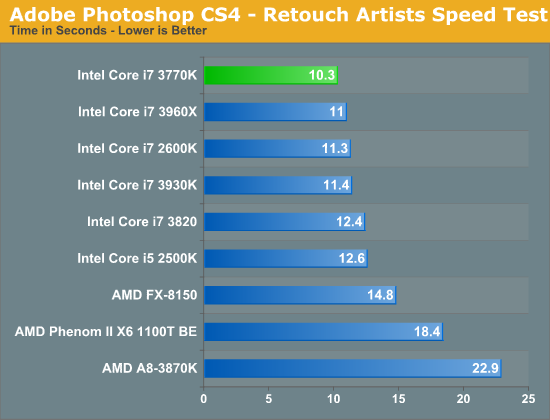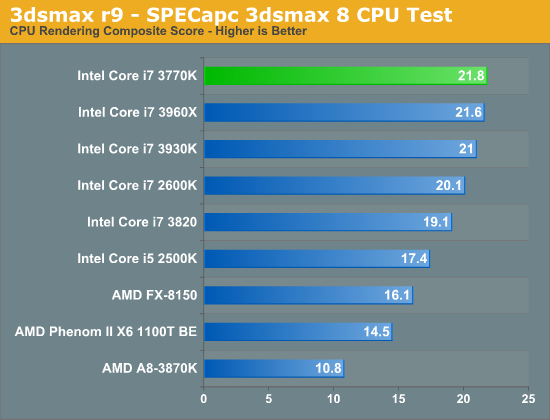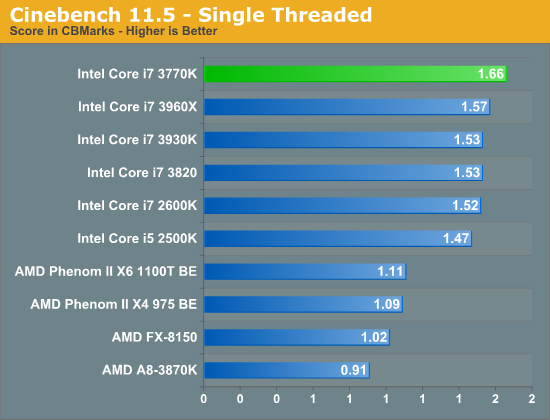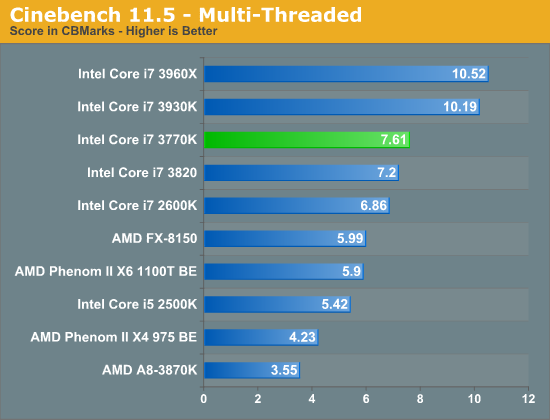The Ivy Bridge Preview: Core i7 3770K Tested
by Anand Lal Shimpi on March 6, 2012 8:16 PM EST- Posted in
- CPUs
- Intel
- Core i7
- Ivy Bridge
Content Creation Performance
Adobe Photoshop CS4
To measure performance under Photoshop CS4 we turn to the Retouch Artists’ Speed Test. The test does basic photo editing; there are a couple of color space conversions, many layer creations, color curve adjustment, image and canvas size adjustment, unsharp mask, and finally a gaussian blur performed on the entire image.
The whole process is timed and thanks to the use of Intel's X25-M SSD as our test bed hard drive, performance is far more predictable than back when we used to test on mechanical disks.
Time is reported in seconds and the lower numbers mean better performance. The test is multithreaded and can hit all four cores in a quad-core machine.

Our Photoshop test is well threaded but it doesn't peg all cores constantly. Instead you get burstier behavior. With the core count advantage out of the way, SNB-E steps aside and allows the 3770K to step up as the fastest CPU we've tested here. The performance advantage over the 2600K is around 9%.
3dsmax 9
Today's desktop processors are more than fast enough to do professional level 3D rendering at home. To look at performance under 3dsmax we ran the SPECapc 3dsmax 8 benchmark (only the CPU rendering tests) under 3dsmax 9 SP1. The results reported are the rendering composite scores.

In another FP heavy workload we see a pretty reasonable gain for Ivy Bridge: 8.5% over a 2600K. This isn't enough to make you want to abandon your Sandy Bridge, but it's a good step forward for a tick.
Cinebench 11.5
Created by the Cinema 4D folks we have Cinebench, a popular 3D rendering benchmark that gives us both single and multi-threaded 3D rendering results.

The single threaded Cinebench test shows a 9% performance advantage for the 3770K over the 2600K. The gap increases slightly to 11% as we look at the multithreaded results:

If you're running a workload that can really stress multiple cores, the 6-core Sandy Bridge E parts will remain unstoppable but in the quad-core world, Ivy Bridge leads the pack.










195 Comments
View All Comments
niva - Wednesday, March 7, 2012 - link
I think it's a long time away from approaching 560m performance. If you're going to do any remotely serious gaming on a laptop it's still best to get a dedicated graphics card.I'm still sticking to gaming on a tower, so these CPUs (esp the AMD llano) make sense for me in laptops. Don't ever see myself gaming on a laptop unless I completely get rid of the towers in my house... which won't happen anytime soon (if ever.)
pepperoni - Wednesday, March 7, 2012 - link
I felt the same way when I was shopping recently. I WANTED to buy a Llano-based notebook (inexpensive, better graphics vs. Intel). The problem is there's no such thing as a slim and light Llano. Every OEM sticks you with the same configuration: six pounds and 15.6" turd-768 resolution screen. It's bizarre.For the sake of competition, I hope Trinity will get some better design wins.
CeriseCogburn - Sunday, January 27, 2013 - link
If you look at the gaming charts, the resolution may go past x768, but the settings are on LOW, and don't give us a minimum frame rate, so the answer is:That's all that llano can handle is low end low rez.
So AMD forces the giant .lb weighted monster as a selling point.
poached - Wednesday, April 18, 2012 - link
so AMD?Demon-Xanth - Wednesday, March 7, 2012 - link
I agree with you there. To get those "$100 mid range GPUs" on a laptop you need to bump up the cost by around $400 to get to one that simply can have one. Most laptops currently do not have discrete GPUs.I am glad to see that integrated graphics from both Intel and AMD can now be compared with low end cards like the GT520 and GT440 without it becoming a laugh. Also that they are actually completing the tests well now. That is a rather major step. I remember some reviews of integrated graphics that resulted in a lot of either "could not complete" or "the bar is too small to fit a number on" entries.
Azethoth - Wednesday, March 7, 2012 - link
The IGP provides the QuickSync implementation. It would be insane to not include the silicon for it on the high end system. In addition moving forward you can get compute work out of the GPU so why would you ever not include it.danjw - Wednesday, March 7, 2012 - link
Quicksync the Intel video transcoding feature is based in the GPU. This is important to a lot of users.sweetspot - Wednesday, March 7, 2012 - link
Well also these make for nice office machines. So businesses upgrading there desktop workstations.When you have thousands of employees, the desktop refresh, these are decent option, since they are not gaming at work ( right lol ).
Taft12 - Sunday, March 18, 2012 - link
Hardly any large corporations buy desktops anymore. Maybe for the call centre employees, that's about it.AFUMCBill - Wednesday, March 7, 2012 - link
Because gaming isn't the only thing that uses graphics cards. For instance, more and more video editors use the graphics card for doing video decode/encode/applying effects. So having a high performance graphics engine to go along with the high performance CPU can be a really nice thing.